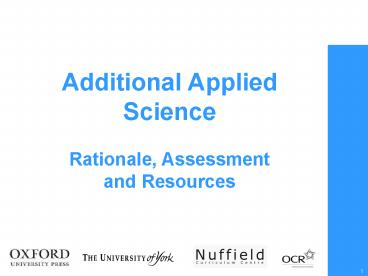Additional Applied Science Rationale, Assessment and Resources - PowerPoint PPT Presentation
1 / 21
Title:
Additional Applied Science Rationale, Assessment and Resources
Description:
Bottom 40% of UK workplace earn less than 2/3 of the pay of ... A6: Rolls Royce testing turbine blades. National Physical Laboratory measuring temperature ... – PowerPoint PPT presentation
Number of Views:67
Avg rating:3.0/5.0
Title: Additional Applied Science Rationale, Assessment and Resources
1
Additional Applied ScienceRationale, Assessment
and Resources
2
Some figures
- Bottom 40 of UK workplace earn less than 2/3 of
the pay of German counterparts - Why? Lower percentage in education post-16
- National Commission on Education Follow-up Group
(Dec 2003)
3
Applied Science courses
- Motivate potential school leavers
- success at all levels
- meaningful hands-on experiences
- assessment larger coursework
- real employment prospects
4
Work-related learning
- A statutory requirement at KS4
- rationale
- The student a broad and balanced education
part of fully preparing for an adult life - The economy the countrys economic well-being
- learning
- through work
- about work
- for work
- audited
5
Applied Science courses
- Major challenges
- authenticity, as employment patterns
change - perceptions of students, parents, teachers
and employers
6
C21 Additional Applied Science
- Aim
- To meet the needs of students who wish to
develop their scientific understanding through
authentic, work-related contexts.
7
1993 study - CSTI
- Occupational group number (000s) Category
- Nurses midwives 467 critical
- Agriculture/horticulture/forestry/fisheries 329
enhanced/significant - Engineers (all types) 311
critical - Chem/gas/petroleum process operatives 161
enhanced - Medical doctors dentists 156
critical - Lab science technicians 130 main
- Medically related occupations 128
main/critical - Food processing operatives 113
enhanced - Secondary school science teachers 106
significant - Product, works and maintenance managers 86
significant - Marketing sales managers 73
significant - University/HE/FE teaching professionals 64
main - Engineering technicians 60
critical - Biological scientists and biochemists 49
main - Chemists 39 main
- Physicists, geologists, meteorologists etc 28
main
8
Additional Applied Science
- Choose any 3 modules from
- Life care
- Agriculture and food
- Scientific detection
- Harnessing chemicals
- Communications
- Materials and performance
9
Key features of the course
- 1 Cluster of related workplace contexts
- 2 Authentic procedures and techniques
- 3 Underpinning science knowledge
- 4 Employers, regulators, social values
- 5 Problem-solving - applying knowledge
10
Key features of the course
- 1 Cluster of related contexts in which people
apply science in their work - but with freedom to
adapt to local circumstances - assessment Work-related report
- 2 Authentic procedures and techniques where the
results matter - adapted as necessary for school
labs - assessment Standard procedures
11
Key features of the course
- 3 Underpinning knowledge - with a degree of
coherence and including some big ideas of
potential value for progression - assessment Module Test
- 4 Framework within which people apply science
(organisations, employers, regulators, social
values) - assessment Work related report, Module Test
- 5 Applying knowledge and techniques to solve a
practical problem - assessment Suitability test
12
Internally assessed skills
- Authentic and manageable Work-related Portfolio
- Six standard procedures (2 per module) - 12
- One suitability test - 21
- One work-related report - 17
- Additional Applied modules have been developed to
take 36 hours, leaving time for skills assessment - Teachers arrange coursework differently to suit
their curriculum and students
13
Module structure
Example Ap2 Agriculture and food
14
Scheme of work (each module)
- 35 hours of guided classroom activities 10 hours
for skills assessment FLEXIBILITY - through work science-related work experience
placements - about work practitioner focus, visits from to
local workplaces - for work work-related portfolio, underpinning
knowledge
15
Video sequences for the course
- Locations
- A1 Human performance lab, Middlesex Uni
- Diagnosis and treatment from GP to hospital
- A2 Longley farm - from cow to yoghurt
- A3 National Gallery examining paint
- Food standards officer, Haringey
- Environmental Agency monitoring a stream
- Cape Farewell gathering data about life in the
Arctic seas - A4 Manufacturing agrochemicals
- A5 Ferraris Respiratory testing baby monitors
- A6 Rolls Royce testing turbine blades
- National Physical Laboratory measuring
temperature
16
Student books
- Referenced from the scheme of work
- Case studies
- People and organisations
- The science
- Procedures and techniques
- Coursework overview
- Glossary and index
17
Progression routes
- AS/A Applied Science
- BTEC Nationals in Science
- Other vocational courses and vocationally-related
qualifications - AS/A courses in Biology, Chemistry or Physics
(top students, with suitable choice of modules)
18
Challenges for technicians
- volume of practical work
- ordering new apparatus and consumables
- storage
- providing for varied tasks in the classroom
e.g. Suitability tests - maintenance of frequently-used kit
19
Challenges for teachers
- Addressing perceptions of students parents
- Capitalising on the freedom,
not letting it be a burden - Meeting the diverse demands
for equipment, materials and ICT - Making connections with the working world of
science - Managing the assessment
- Offering progression to post-16 courses
20
What do teachers say?
- Pupils enjoy the
- practical work involved
- It is a genuine pleasure to be working with
pupils in these lessons
- The grades that students achieve are typically
one grade higher than we might expect from
previous science courses
Attitudes, motivation and achievement in science
improve during the applied course
21
Websites
- General information www.21stcenturyscience.org
- Publications from OUP www.twentyfirstcenturyscien
ce.org - Specifications, assessment and training
www.ocr.org.uk































